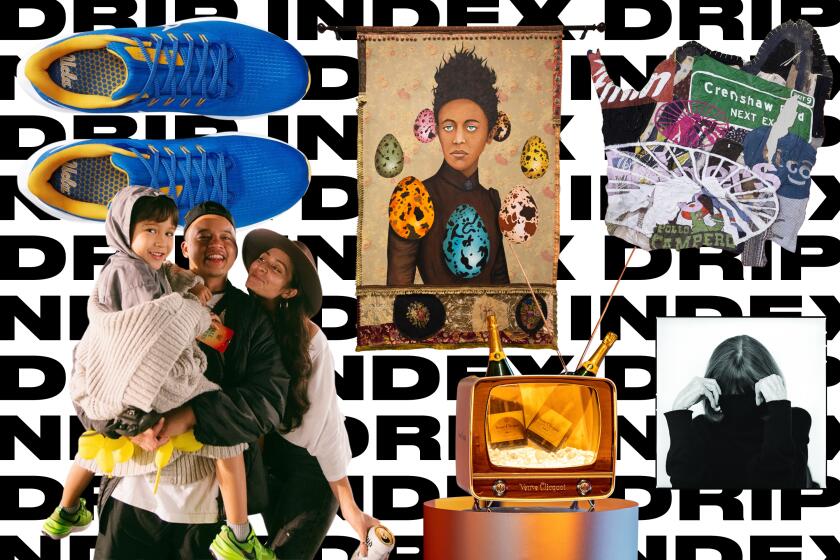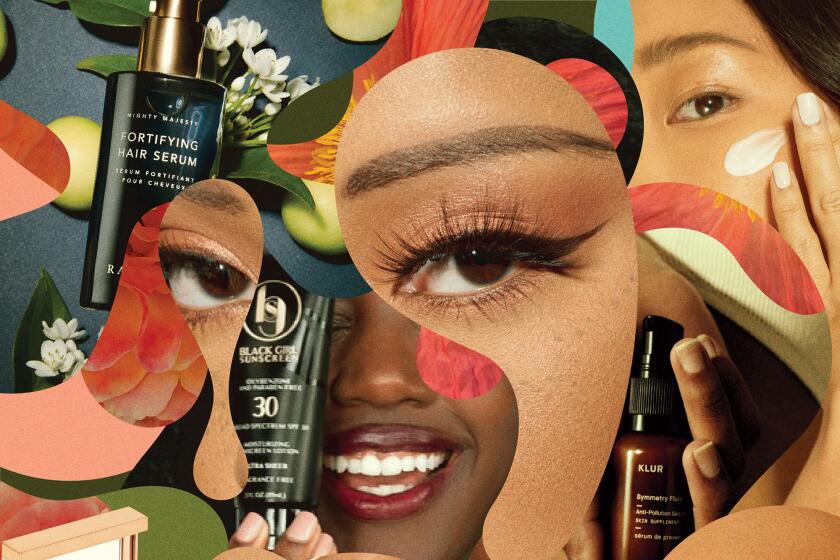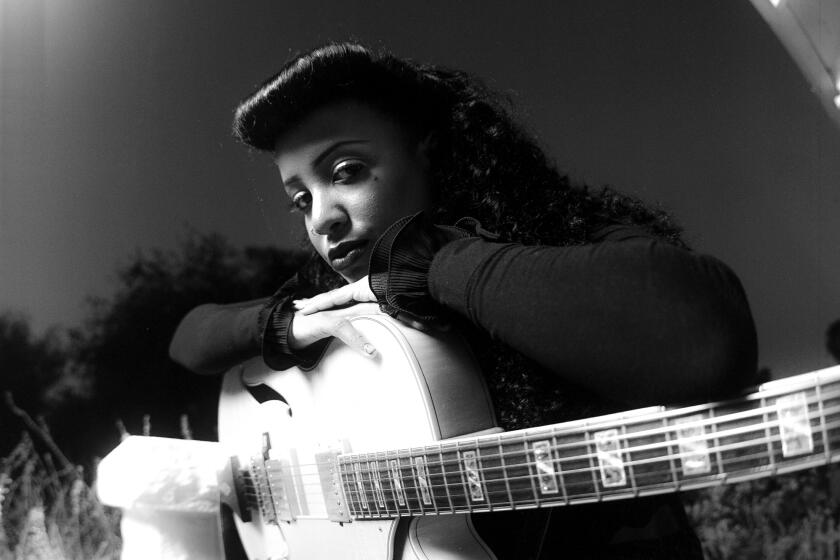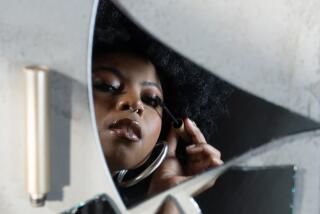- Share via
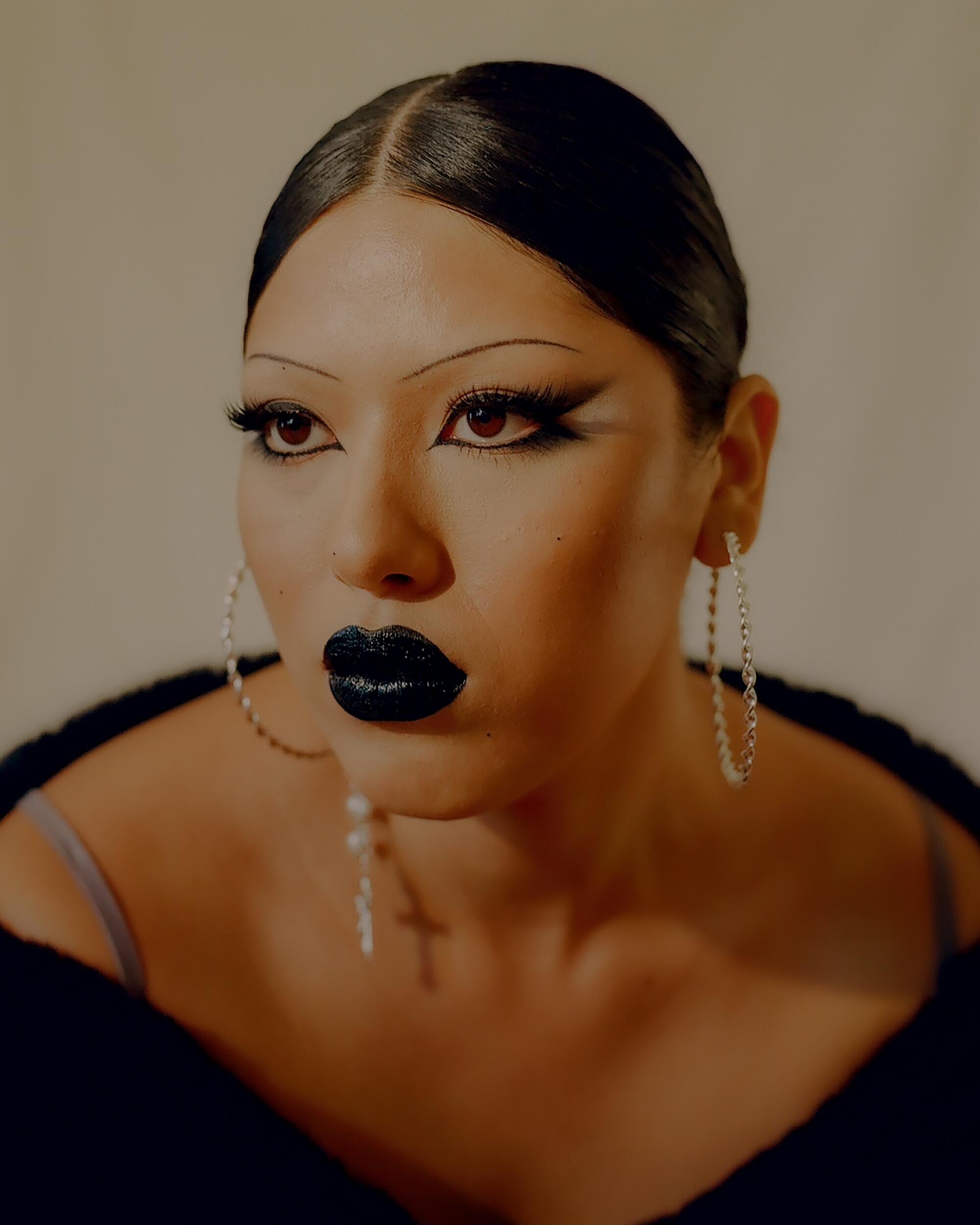
This story is part of Image Issue 14, “Elevation,” where we examine beauty as a state of being, a process of realization. Read the whole issue here.
I’m screaming, I’m tweezing. I’m plucking my skin raw. Three hairs yanked out at once, and my sights are set on more. Starting at the front of my brow, I am creating a path for the remaining shape. I get up close to the mirror, remove my hair and step back to assess. Back and forth, back and forth.
See, what I really need is a new look. The pause on ambition during the pandemic has timed out, and we’re back to chasing the bag. Maybe if I carve a different expression onto my face I’ll develop the confidence to keep up. A recession looms, and for some it’s already here. Fame — of any kind — is becoming necessary if you’d like to continue living on one (or both) of America’s glittering coasts. Every outfit worn or sentence written now has the added pressure to save your life. It’s a good time to pull your hair out.
#thineyebrowchallenge on TikTok shows me the lay of the land. It’s a filter that shows how you’d look — before you commit to hair removal. The goths, of course, are ahead of everyone with tutorials on how to shave off brows and draw them back. Latinas affectionately post about looking like their mothers in the ’90s. Women prank their boyfriends, dads and brothers by pretending to groom their brows just to reveal the results on their front-facing cameras. Millennials vehemently reject the challenge, refusing to let Gen Z take away their 2010s fluffiness. Brooke Shields participates in the challenge as an April Fool’s Joke by covering up those legendary blocks of hair and drawing on two thin lines. Someone comments: “Your eyebrows are ICONIC AND GORGEOUS! Never change them; an entire generation would mourn.”
Perhaps it’s that time of the century when hair comes off. The 1920s, like the 1990s, were a time of reverie before chaos. I think flappers and waifs could feel the impending doom. Clara Bow said once: “All the time the flapper is laughing and dancing, there’s a feeling of tragedy underneath. She’s unhappy and disillusioned, and that’s what people sense.” Bow’s eyebrows were drawn in a sad slant, making hers the most expressive face of the silent era’s final years. She did star in a few talkies, but the new microphones made her suspicious, causing her to ruin takes by staring at them overhead too often. She retired at 28. Jean Harlow rose to fame after the crash of 1929, and the desired brow look remained thin. Now the eyebrows were arched and high on the forehead, giving her a look of shock appropriate for the era. Harlow entertained audiences throughout the majority of the Great Depression before her death in 1937.
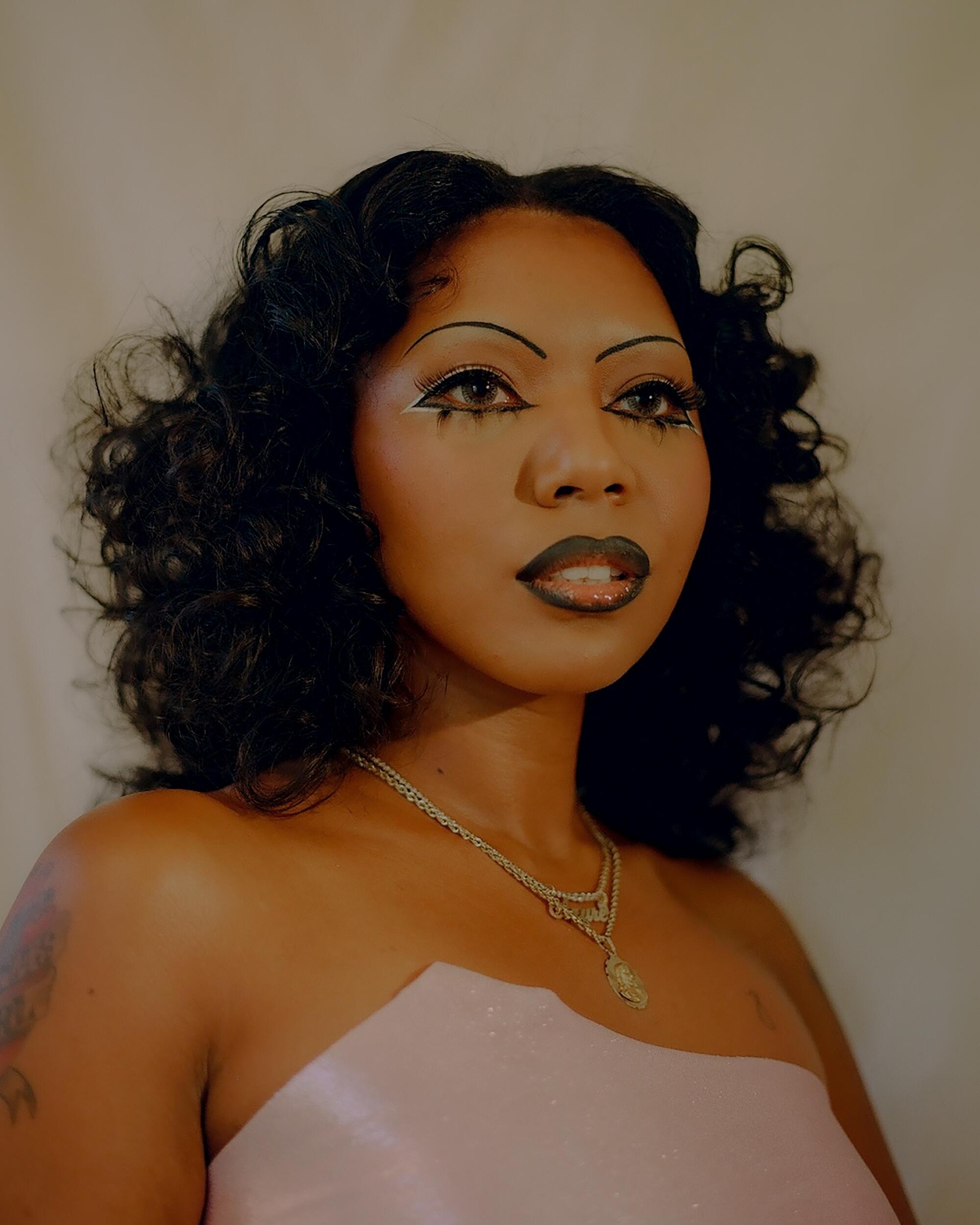
The 1940s and ’50s returned to a natural look while America busied itself with seizing power during WWII. By the Nixon years eyebrows were tweezed again, with Twiggy bringing us back to our patriotic anxiety. The look fluctuated in and out of popularity until 9/11 gave it a reason to stay. Today, I see skinny eyebrows paired with the low-slung Y2K miniskirts of my childhood every time I go out. What do these girls know that we don’t?
For transsexual reasons that don’t belong in this essay, I want to feminize my face. More space around the eyes is an easy way to do it. Another way would be surgery — which I’ve gotten in other areas of my body — but something urges me to keep the face I was born with. It’s the only thing from my family that I’ve kept. We’ve all got my grandmother’s eyes, and the same sparse hairs above them. Our family isn’t capable of the Cara Delevingne look that dominated the entirety of my 20s.
For years I’ve asked my eyebrow lady to go thinner but she never budged. So I took matters into my own hands. One eyebrow ended up thinner than the other, with less of an arch, but I was closer to the vision I had for myself. After the hairs began to grow back, I went to see her for a touch-up. With nowhere else to go, she had to give in to the look I’d been asking for. The shape was already there. Feeling the thread go higher than usual brought satisfaction and a little pain, a prickly mix of complementary sensations. When it’s over, she speaks two words I’ve never heard in 12 years of being her customer: “Looks nice.”
More stories from Elevation
Jason Parham revisits the Smokey Robinson of hip-hop, Nate Dogg
Rikkí Wright unpacks the beauty routine as a metaphor
Rembert Browne comes of age without a hairline
Dave Schilling investigates why the mullet is the haircut that refuses to die
The state of L.A. beauty in one zine
Recently, I found a photo of my 18-year-old mother on her way to a wedding in 1974. My uncle’s boyfriend Bill has his arm around her and she’s almost smiling. Her pink-lined lips point upward for the camera but dip into a grimace at the last second. Dark eyeshadow swings her eyes upward and the brows are barely visible. There’s a nervousness in this photo. I wonder if Bill can feel it too, as he seems to be squeezing her shoulders in encouragement. It’s her first year in this country, and she can hardly speak the language. When I was a child, she proudly hung a different photo from the same day on the wall. Every time she caught me looking at it, she’d say the same thing: “It took me five hours to get ready!” What I heard was: Appreciate my labor. My mother sees this day as the pinnacle of her youth, and speaks of her beauty in the past tense. From what I know, the beauty of this image wasn’t even hers that day. I know that her first husband is just out of frame, already making life difficult. In my earliest memory I am sitting next to her on an airplane from New York to Lima, Peru. Everything is dark and turbulent. My mother, who hates flying, isn’t doing well. I’m 5 years old and failing to calm her down, wiping the mascara tears from her cheeks. When I tell her this story, she says she doesn’t remember.
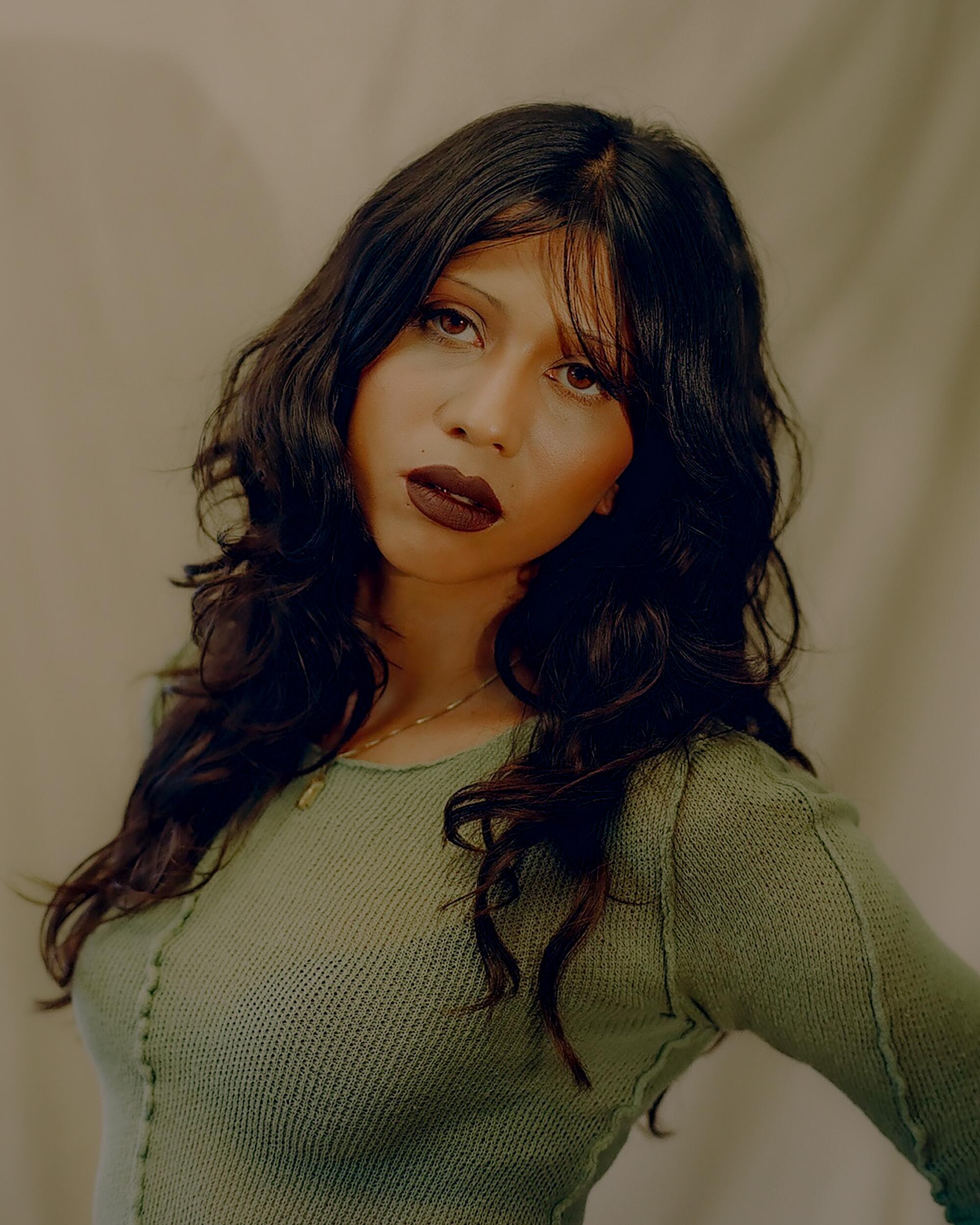
Now I see stubble on my eyelids. Hairs are growing back, but the follicles are too small to be pulled out. My only salvation is to cover them with makeup, but I don’t have the energy for this so I lock myself away for a few days. Even though it appears to be a depressing pit of isolation and takeout meals, I call it a beauty hibernation. I am allowing leg hairs to grow in to avoid bumps. My pores are taking a breather from the foundation, and the oils from my unwashed scalp are conditioning my ends. I like to sit in my stink and contemplate the future. Like last Christmas, when I bought pink hair dye hours before finding out I was infected with Omicron. Running a fever, I covered my bleached ends with pigment and watched my bank account shrink in the following days as I had everything delivered. The results were patchy, worsening the effect of my grown-out roots and sallow skin. When I returned to the world I bought black hair dye, hoping it would return me to that place of the perfect “before.” No one ever saw the pink.
I still haven’t dealt with everything we’ve lived within the past two years, and I am beginning to distrust my memory of it. Fittingly, the new space above my eyes gives me a look of wonder. Was I paying attention to the wrong things? Did I, by not knowing how to live, get stuck with someone else’s life? The poet Fanny Howe writes that bewilderment “circumambulates, believing that at the center of errant or circular movement, is the axis of reality.” I’m spinning. I can’t exercise, read or write. In this state of bewilderment I have developed an aversion to anything that might be good for me. Maybe if I display all this on my face, I can move on. By telling the truth, will I end up where I’m supposed to be? We’ve lost our way of life, and I’m praying for the clarity of vision to build a new one. If the eyes are the windows to the soul, I’m pulling the curtains back. Letting a little light in; clearing out some room. We’re not in hell yet.
Devan Díaz was born in Elmhurst, N.Y., but grew up in Smyrna, Tenn. Her writing has been featured in SSENSE, the Guardian, Artforum and Vogue. She now lives in Jackson Heights, Queens.
More stories from Image
